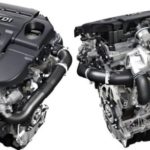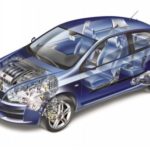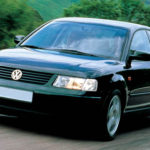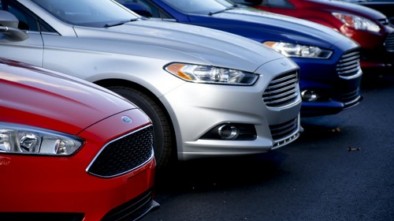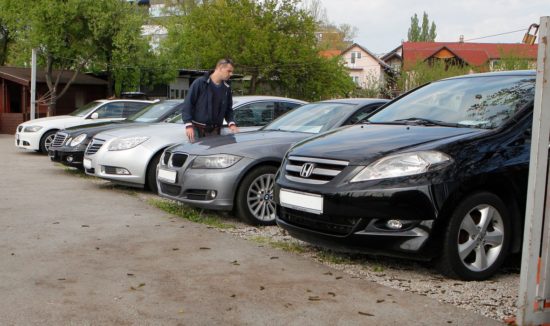Instructions for viewing and buying a used car
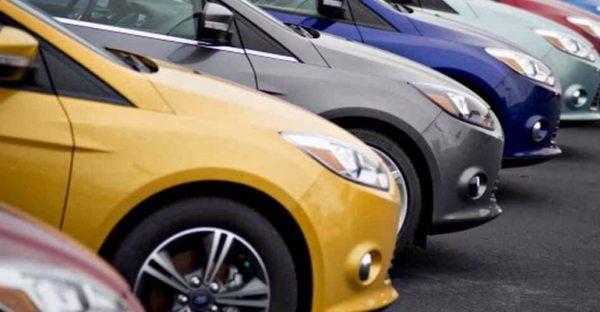
Used Car Review
The economic standard in our country unfortunately does not allow all citizens to afford to buy a new car. Often, a large number of those who choose to buy a vehicle resort to the option of caring for a half-car.
In this article, we will try to give a detailed guide to buying a used car to all those who are planning to buy a used car of any brand by taxatively stating the basic facts and details that need to be considered when reviewing a vehicle.
01. Overview of traffic documents, certificates, service booklet…
An inspection of the paperwork and origin of a vehicle is one of the most important elements of a vehicle check when making a purchase. Despite the fact that the vehicle can be mechanically and aesthetically in exceptional condition, if it turns out that the paperwork of the vehicle is "not clean", there can be major problems, and eventually even the possible seizure of the vehicle by the interior authorities.
We advise you to go chronologically by checking the vehicle history if possible via a service booklet check. Keep in mind that many imported vehicles have a counterfeit booklet to restore vehicle mileage and to show regular maintenance, so be careful. If possible, check the origin of the vehicle with the importer in case there is a dependent vehicle history. In case the vehicle was purchased in our country, you will have a slightly easier job, but be sure to check all the quotes related to the regularity of servicing at the prescribed interval, as well as any possible breakdowns if any.

Check the validity of the attestation if the vehicle has a gas appliance, as well as the details of whether there are conditions for attesting the appliance if this is not performed, with the cost of this "formality", of course.
Another way you can check the authenticity of a vehicle, as well as some basic information about it, is to read the chassis number or VIN number using the appropriate software.
Mileage is increasingly the "target" of sellers who want to sell their vehicle at the best possible price, and is subject to reduction and popularly called "return". Don't be fooled by the numbers. Make sure you always know whether it is of real or unrealistic value by checking the vehicle or consulting the owner.
02. Sheet metal and exterior detailing
-detail on sheet metal and paint (scratches, small damages, damage from the city, etc.), bumps, "color diversity"
If the car has minor scratches from regular use or some other minimal aesthetic phalling, this is often accepted as a normal thing. Major damages include damage to the harder-to-repair city, greater bumps on the sheet metal, as well as greater “knocking”.
Often, (re) dealers polish the vehicle to make it look better or to conceal any major car accidents, so we recommend being careful. Often, some owners only paint the bumpers to improve the aesthetics of the vehicle, but caution should be exercised as it is often possible to identify a car that has been badly damaged by the different bumper and wing colors.

- possible major interventions on the tin plate of the vehicle - gating, complete painting, changing of vital parts of aesthetics (bumpers, masks), welds, etc.
Complete vehicle painting is often a very important parameter in aesthetics. Ask the owner to tell you why the car is and how it is painted? Did he have a breakdown or is there some other reason. If you find that a part of the car has underglaze paint, carry out a thorough inspection of the complete bodywork.
- surface and deep corrosion on sites, edges, wings, floor, trunk and all other parts of the vehicle including complete car with chassis
Surface corrosion can often be present in most halves. It is "less dangerous" than the depth in which case the complete parts of the sheet metal (edges, siding, floor, wings, etc.) must be replaced. It is also necessary to inspect the floor of the vehicle as lightly as possible, while the easiest way to inspect the trunk is by lifting all the plastics, the cutting wheel and stripping it all the way to the sheet. You can often see that there are no cases of corrugated sheet metal or traces of damage, as well as greater corrosion.
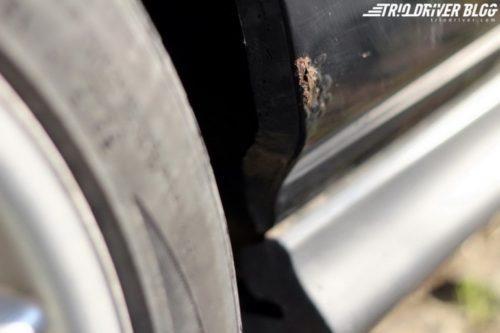
- sheet metal accessories - spoilers (factory, non-factory)
Often, this group of accessories, if factory or non-factory stylized, can increase the price of the vehicle while improving the aesthetic and technical performance of the vehicle. In some cases, spoilers or website edges may "hide" rust, so it is advisable to inspect the parts below to avoid being surprised by the purchase. If the accessories are close to the ground, this may reduce the convenience of using the vehicle itself.
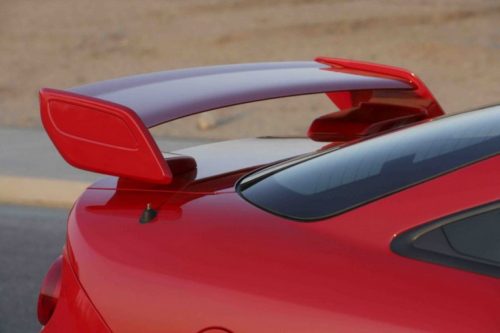
- authentication of all vehicle markings, badges, moldings
When leaving the factory, the vehicle has factory signs and badges in the defined locations. If they are missing somewhere, often the reason for their absence can be banal, but sometimes it happens that the car has suffered a "knock", and then painting these marks are not returned to the old places, so one should be careful and always examine what it is about.
- checking the roof
Make sure all sub-covers are in place. It is a very common case that the owners do not return them to their places after some accident, so it can be recognized that the car had an accident, and the absence of a sunroof can increase the corrosion of critical points above the wheels over a long period of time.
- check the gap between the elements of the tin (doors, hood, bumper, headlights)
Checking all the gaps between the sheets or light groups and windows can often indicate that the car has been damaged. Where the gaps are "larger or smaller," everything should be thoroughly inspected because there is an indication that something is not right.
03. Light Groups and Glass Surfaces
- authentication of headlamps, fog lamps, tail lamps and other lighting groups, if any
By light groups you can often conclude that the car had some contact with another vehicle or a third object. Original vehicle headlamps should be marked the same by the same manufacturer. The newer headlamp is recognized by a stronger "glare" than the old one, which is mostly "matte".
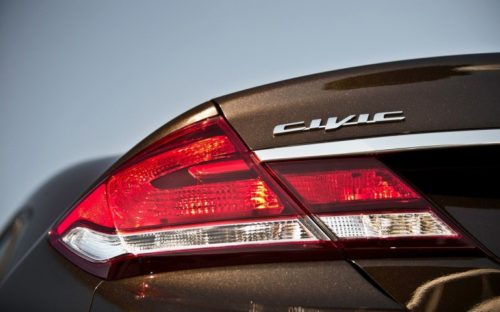
- checking the conversion of light groups
In some accidents, owners are unable to find light-related groups that fit models that may be older or may have been removed from other equipment (restyled), so you should pay attention to that detail as well as aftermarket conversions.
- authentication of all groups of windows on the vehicle
Glass surfaces can sometimes be damaged by their markings, numbers and year of manufacture, in most cases you may notice that something has happened to the car in the past and be careful.
04. Wheels and tires
- check the dimensions of the rims and tire
The dimensions of the rim are directly related to the dimensions of the tires for the comfort of the vehicle, its fuel consumption, as well as the "condition" on the ladder.
Driving with oversized wheels on bad roads (such as ours) can significantly reduce the life of the chassis, tires, and other vital parts of the vehicle. It is best for the wheels and tires to be in the factory frames, or with a certain minimal deviation.
- Check the aesthetics and condition of the rims
If the rims on the car are wrong, it can often transmit and create various shocks to the vehicle itself which can be felt while driving. When it comes to "micro aesthetics" on the wheels themselves, it is a secondary thing that you can pay attention to because they can be restored to enviable condition by a certain level of arranging (with the intended financial investment).
- age check tire, their patterns, models (ms) and even wear
If the tires are old, they have lost their primary characteristics and should be replaced. It's the same with the depth of the pattern. If it is below average, the tires need to be replaced. If your car has winter tires and you do not get an extra set of summer tires, you need to anticipate the cost of purchasing a summer set of wheels and tires.
Unevenly worn tires fitted to the vehicle at the same time may indicate improperly adjusted trap or even the existence of some accidents in the past, which are the cause of poor wheel traction.
05. Engine compartment and engine aggregates
- Checking the hoops and paint inside the engine compartment
Check the vehicle 's' baskets, often forming corrosion in the dampers of older vehicles, which is known to be a major problem. Also, check that they are not by any means "crowded", that is, the vehicle did not receive in the past the impact that had transmitted to them.
The paint inside the engine compartment may indicate if the car is painted outside.
- Checking the joints of sheet metal elements from the inside (wings, engine compartment, firewall, connecting sheets, headlamp mounts
Check the joints of the wing of the vehicle with the other parts of the shell, that all the welds, the connecting plates are in order, that by any chance there is no "creasing" on the sheet itself.
Headlamp carriers are often broken or glued if the car has had an accident, and often indicate that something is wrong.
- visual inspection of the external dryness of the engine and possible washing of the engine
When viewed from the top, the engine can give the impression of dryness or humidity. Often, oil can break in and out of the engine in areas of the head gasket, manifold gasket, gearbox gasket, and other potential places. Try to tuck under the vehicle and check the crankcase for any oil marks.
Be especially careful when purchasing that the engine is not by any means freshly washed. (Pre) sellers often take that step to undo and mask the loss of oil, as well as the primary mess of the engine.
- visual inspection of all engine components as well as the basic elements of the engine (girl, alternator, belt, fluid bottle, battery and age, exhaust and suction branch, radiator, etc.)
Check that the basic vehicle components are in order. Sometimes the oiliness of the part of the girl near the oil plug can indicate that the car consumes the aforementioned and that this is due to regular refueling. Belts can often be visually inspected to see that they are not cracked, torn, etc. Check the battery and its age. Inspect the refrigerator to make sure it is not rotten or distorted by any accident.
- inspection of oil, antifreeze, brake fluid and other vital fluids.
This inspection is mandatory and may indicate directly the condition of the engine. If the engine oil level is low, it is suspected that the engine will burn or lose it at some point. If the antifreeze level is low, it may indicate possible engine cooling problems, which can be of great importance. If the oil, brakes, servo and other hydraulic assemblies is at a minimum, it is a sign that there is a loss of oil within the system.
06. Car Interior
- overview of the steering, pedals, transmission, seats
The wear and tear of the steering wheel of vehicles, pedals and gearboxes can often indicate a large number of miles. In some cases, the weariness of these elements comes from the driving style, the progressive sweating, as well as the quality of workmanship in a particular model, and one should not be overly paranoid.
The interior, seats and other parts and aesthetics are conditioned by the maintenance and handling of the vehicle owners, in addition to the number of kilometers, and should be taken into consideration.
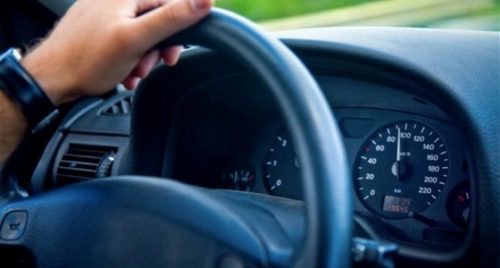
- inspection of switches, lifters, signaling, electronic and mechanical aids in the vehicle
You can review all of the above in this spot. If some items are not in good condition, they can often be repaired with less cash, while sometimes problems with the operation of certain electronic systems can be costly, and one has to be careful.
- start the engine and view the active indicator lights on the control panel
When making a "first contact" and starting the engine, it is necessary to determine whether the car may report a fault (Check engine). This error can sometimes signal a banal problem, while it can sometimes be more reported, and you need to be careful about why they occur.
- inspection of the trunk, as well as the space below it where the spare wheel is located, with complete hinging on the hips and pathos
We have already mentioned the overview of the trunk and luggage space in the section concerning the tin. When it comes to it is necessary to lift all washers and carpets to determine that by any chance there were no major sheet metal work in the area of the rear hair or trunks, as well as five (third) doors.
07. Vehicle inspection prior to driving test
Before inspecting the vehicle while driving, you can inspect whether the car emits exhaust fumes of a specific color, which indicates that there is a problem with the engine or combustion.
Have someone push the vehicle once to a blockage while you observe the condition on the exhaust. Below are the colors that indicate the symptoms:
Blue smoke
If the car emits blue smoke it means there is some problem with the oil and that a certain amount of combustion occurs. This is most often manifested when the links or valves come out, and then the oil leaks into the combustion chamber in which it is mixed with the fuel.
Gray smoke
For such a color of smoke it is difficult to make the right diagnosis. It is caused by similar failures as in the case of blue smoke, oil combustion, but also a bad turbocharger (if the car has one).
White smoke
If there is white smoke it does not have to mean that it is a malfunction, as it may represent normal condensation within the exhaust system. However, a larger white smoke cloud may already be a risk. The main malfunctions that can cause white smoke are damage to the cylinder head and cracked walls of the engine block, which requires costly repairs.
This problem should not be ignored, since even the smallest amount of coolant leakage can lead to overheating and a high risk of engine failure.
Black smoke
Black smoke is a symbol of high fuel consumption. The first thing to check is the air filters, intake sensors, fuel injectors and pressure regulator. Black smoke is the easiest to diagnose because it knows exactly what is causing it, and repairing and replacing parts is not overly expensive.
After reviewing this item, we recommend moving to a vehicle inspection while driving.
08 - Vehicle inspection while driving
At the beginning, after starting the engine, try listening to its engine. If you have had previous driving experience, you can easily notice some strange noises if any, such as "restless operation", a decrease in engine speed, etc.
- By crossing all the wheels over certain bumps or lying cops, you can check if there are any sounds that can symbolize trap problems. It's throbbing, rattling, rustling, etc.
- With the full winding of the steering wheel first on one side and on the other, you can check the condition of the homokinetic joints. If their "mingling" is heard, it is a sign that they are worn out.
- by accelerating, you can test whether the car is moving according to its strength and weight as it should or is sluggish
- how does the transmission break into gears? Are there any sounds when changing gears or while the car is in the back?
- does the steering wheel shake at high speeds or braking? If it shakes, the wheels may not be well balanced or the car may have some trap problems. There is also the possibility that the brake discs are to blame.
- Do the brakes squeal when braking? If it creaks, it may be that they are worn out or that it is a specific model of creaking tiles (claim)
- does the car brake properly and does not fall when the brake pedal is depressed?
REMARK: Experience is needed to diagnose some of the above symptoms. Therefore, if you are not into matter, we recommend that you leave it to a mechanic or someone with more experience than you.
09. Car chassis inspection
When it comes to car chassis and inspection of the complete trap, suspension, exhaust system, floor and other parts of the vehicle that cannot be seen without lifting it on the crane, we advise you to leave this part to professionals in one of the professional services that offer vehicle inspection, or to have it done for you by a person who has sufficient experience to ascertain the real condition of the vehicle.
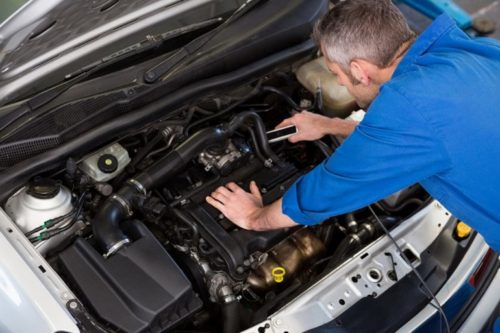
When inspecting the chassis and ladder, we can distinguish the basic elements that need to be checked:
- the engine compartment from below, all its components, belts, gaskets, etc.
- gearbox zone
- shock absorbers, springs, shock absorber cups
- complete front and rear trap (upper and lower balls, clamps, balance bar, steering rack, silen blocks, as well as all other components)
- A branch, pots, and exhaust pipes
- car path condition (corrosion or some damage)
- condition of brake discs and plates
- If the vehicle has all-wheel drive, check the universal joint shaft, joints and differentials
10. Inspection of Gas Appliance
If the vehicle has a gas appliance, check that it is factory fitted or retrofitted. Record the service that performed the installation and which model of gas device is in question.
- is it a sequencer or a "regular" gas device?
- has the device been certified?
- is it registered in the traffic permit?
- when does the certificate expire?
- test engine and vehicle behavior on LPG
11. Inspection of accessories
Vehicle accessories, whether factory or aftermarket installed, can greatly affect the value of the vehicle. What should be noted is that it can often be very practical as well as of benefit to the future buyer, while it can also be one of the unnecessary accessories that can often complicate driving itself, increase vehicle consumption, spoil its comfort, and affect the overall sustainability of mechanics.
Accessories can be divided into visual accessories, mechanical (technical), audio, functional, etc.
Some of the things that can certainly come in handy with the vehicle are: an extra set of wheels (winter / summer tires), a music player and speakers (if you are a fan of good vehicle sound). Some of the security systems (if you are driving a car that is susceptible to theft), glass tinted in accordance with the law, modifications to the exhaust and suction system, etc.
Also, there are some accessories that can reduce the practicality of using a vehicle in the case of being radical or non-standard on the vehicle. These can be lipsticks, spoilers and bumper discharges that are not specific to our roads and the vehicle itself, through the inadequate selection of rim and wheel dimensions (they often happen to be oversized, which affects the vehicle's grip and comfort), the overly lowered vehicle (often by physical shortening) shock absorber spring) etc.
Finally we can give you some more tips. We recommend that you examine the basic things that can be observed and recorded on the ground at the first inspection of the vehicle with a simple view of the vehicle.
If you find that it makes sense to subject the car to a more thorough inspection, we advise you to schedule an inspection at a car service or to have the vehicle inspected by a person who has sufficient experience when it comes to mechanics and diagnostics in the service environment.
Recommendation of similar texts:

Hi there, I am Mladen and I am an auto enthusiast. I started this blog years ago to help like minded people share information about latest cars, car servicing ideas, used car info, exotic cars, and auto technology. You will find helpful articles and videos on a wide variety of cars - Audi, Mercedes, Toyota, Porsche, Volvo, BMW and much more. Ping us if you have anything cool to share on latest cars or on how to make older cars more efficient, or just want to say hi!



